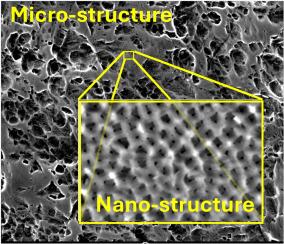新型耐久的纳米/微光子层次化宽带吸收体
IF 6.3
2区 材料科学
Q2 CHEMISTRY, PHYSICAL
引用次数: 0
摘要
本研究提出了一种创新的制造方法,将化学浴蚀刻和阳极氧化相结合,在铝基板上产生层次化的纳米/微结构表面。所提出的方法很简单,使用传统的设备和化学成分,在几平方厘米的大面积上产生准晶体纳米结构。通过成功地阳极氧化多孔铝表面,我们在两个尺度上结合了有益的物理特性:刚性多孔铝结构的低密度和坚固的阳极氧化铝(AAO)层的低反射率。这种双重形态显著提高了材料的光学和机械性能,从而形成了宽带、高吸收性和耐用的表面。硬度的增加与通过化学蚀刻产生多孔层有关,可见光和近红外光学反射率的降低主要是由于阳极氧化产生的纳米孔的存在。最终样品的硬度有了显著的提高,与常规的AAO层相比,维氏硬度增加了两倍,与单独的多孔铝层相比,维氏硬度增加了三倍。此外,与传统的AAO层相比,制造表面的反射率降低了25%。这些发现突出了这种混合制造技术在需要具有优异光吸收,机械耐久性和抗反射性能的表面的应用中的潜力,例如太阳能收集,光学器件和保护涂层。本文章由计算机程序翻译,如有差异,请以英文原文为准。

Novel durable broadband absorber with hierarchical nano/micro photonic structure
This study presents an innovative fabrication method that integrates chemical bath etching and anodization to produce a hierarchical nano/micro-structured surface on aluminum substrates. The proposed methodology is simple and uses conventional equipment and chemical components, generating quasi-crystalline nanostructures over a large area of several cm. By successfully anodizing a porous aluminum surface, we combine the beneficial physical properties at both scales: the low density of the rigid porous aluminum structure and the low reflectance of the robust Anodized Aluminum Oxide (AAO) layer. This dual morphology significantly enhances the material’s optical and mechanical performance, resulting in a broadband, highly absorptive, and durable surface. The increase in hardness is linked to the generation of a porous layer through chemical etching, and the reduction in optical reflectivity in the visible and near infrared is mainly caused by the presence of nano-holes produce by anodization. The final sample demonstrates a remarkable improvement in hardness, with a twofold increase in the Vickers hardness number compared to conventional AAO layers, and a threefold increase compared to the porous aluminum layer alone. Additionally, the reflectivity of the fabricated surface is reduced by 25% relative to traditional AAO layers. These findings highlight the potential of this hybrid fabrication technique for applications requiring surfaces with superior light absorption, mechanical durability, and anti-reflective properties, such as in solar energy harvesting, optical devices, and protective coatings.
求助全文
通过发布文献求助,成功后即可免费获取论文全文。
去求助
来源期刊

Surfaces and Interfaces
Chemistry-General Chemistry
CiteScore
8.50
自引率
6.50%
发文量
753
审稿时长
35 days
期刊介绍:
The aim of the journal is to provide a respectful outlet for ''sound science'' papers in all research areas on surfaces and interfaces. We define sound science papers as papers that describe new and well-executed research, but that do not necessarily provide brand new insights or are merely a description of research results.
Surfaces and Interfaces publishes research papers in all fields of surface science which may not always find the right home on first submission to our Elsevier sister journals (Applied Surface, Surface and Coatings Technology, Thin Solid Films)
 求助内容:
求助内容: 应助结果提醒方式:
应助结果提醒方式:


